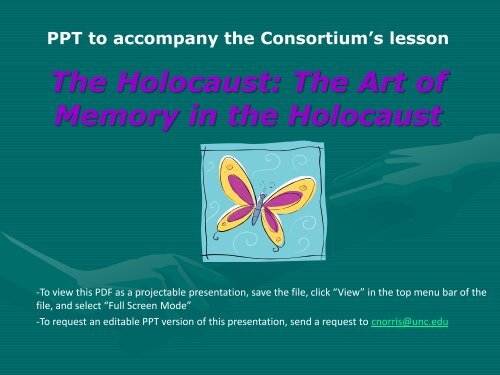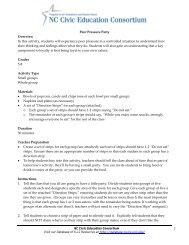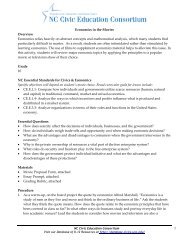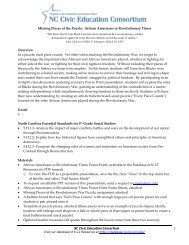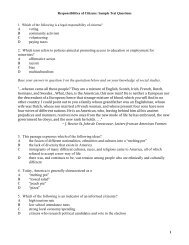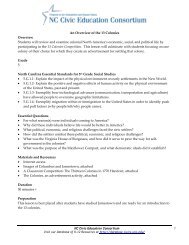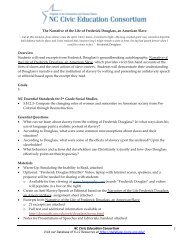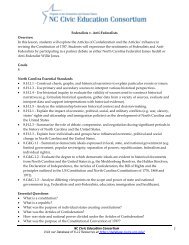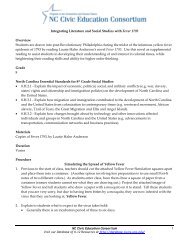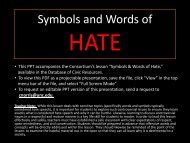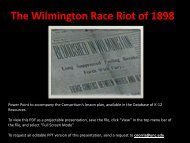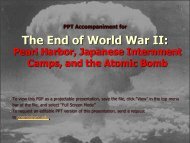PowerPoint Presentation - Terezin Powerpoint
PowerPoint Presentation - Terezin Powerpoint
PowerPoint Presentation - Terezin Powerpoint
Create successful ePaper yourself
Turn your PDF publications into a flip-book with our unique Google optimized e-Paper software.
PPT to accompany the Consortium’s lesson<br />
The Holocaust: The Art of<br />
Memory in the Holocaust<br />
-To view this PDF as a projectable presentation, save the file, click “View” in the top menu bar of the<br />
file, and select “Full Screen Mode”<br />
-To request an editable PPT version of this presentation, send a request to cnorris@unc.edu
Memory<br />
1
About the <strong>Terezin</strong> Concentration Camp…<br />
• Located in Czechoslovakia, <strong>Terezin</strong> was to serve as<br />
the “model camp” that foreigners could be shown.<br />
As of 1941, it became “Theresienstadt,” a ghetto.<br />
• The resienstadt ghetto was created to house “special<br />
categories” of Jews (artists, authors, musicians,<br />
spiritual leaders, children, etc.)<br />
• Against orders, many adults lead classes for Jewish<br />
children, and their art work and poetry lies in the<br />
collection “I Never Saw Another Butterfly” today.
• In 1944 when the International Red Cross gave word<br />
that they would be coming to inspect the ghetto,<br />
elaborate preparations were made to turn the ghetto<br />
into a piece of propaganda.<br />
• The ghetto was cleaned, buildings were painted,<br />
gardens were planted, new furniture was put in the<br />
dorms of prisoners, cultural events were planned…the<br />
concentration camp was staged to look like an<br />
educational and cultural retreat.<br />
• This was the Nazis way of hiding the atrocities they<br />
were committing.
• Yet, in truth, rules and experiences at <strong>Terezin</strong> could be just as<br />
horrifying as any other concentration camp. For example, it<br />
was illegal to write letters to anyone outside of the ghetto.<br />
On January 10, 1942 nine people were hanged, each accused<br />
of smuggling a letter.<br />
• Still, residents were brave and resilient. Against orders, many<br />
adults lead classes for Jewish children, and their art work and<br />
poetry today lies in the collection I Never Saw Another<br />
Butterfly.<br />
• A total of around 15,000 children under the age of 15 passed<br />
through <strong>Terezin</strong>. Of these around 100 survived.
Entrance to <strong>Terezin</strong> camp. The gate<br />
bears the motto “Arbeit Macht Frei”<br />
(“Work makes one free”)
German Jews, wearing identification tags, before deportation to Theresienstadt.<br />
(Wiesbaden, Germany, August 1942)
Departure of a train of German Jews being deported to Theresienstadt.<br />
(Hanau, Germany, May 30, 1942)
The arrival of Jews at the <strong>Terezin</strong> (Theresienstadt) Ghetto, near Prague,<br />
Czechoslovakia.<br />
Prisoners were sometimes allowed to bring a few possessions with them, but often what they<br />
brought was immediately taken away by the prison guards.
A transport of Jewish prisoners marches through the snow from the Bauschovitz train station to Theresienstadt.<br />
(Czechoslovakia, 1942) Even in the worse weather, young and old alike were forced to march from the train station to<br />
the <strong>Terezin</strong> ghetto.
Arrival of a transport of Dutch Jews in the Theresienstadt ghetto.<br />
(Czechoslovakia, February 1944)
Dutch Jews who have recently arrived in the Theresienstadt ghetto. Czechoslovakia,<br />
February 1944.
Women prisoners lie on thin mattresses on the floor of a barracks in the women's camp in the Theresienstadt ghetto.<br />
Czechoslovakia, between 1941 and 1945. The living conditions were quite miserable, and were usually very crowded.<br />
Sicknesses spread quickly among the people.
Preparation of food in the<br />
Theresienstadt ghetto.<br />
(Theresienstadt, Czechoslovakia,<br />
between 1941 and 1945.)<br />
The food for the prisoners was very poor<br />
quality and was prepared in unsanitary<br />
conditions. Food rations were very small.
Prisoners wait for food rations.<br />
Theresienstadt ghetto,<br />
Czechoslovakia, between 1941 and<br />
1945. Prisoners at <strong>Terezin</strong> were always<br />
hungry. Thousands died of malnutrition.
Forced laborers at work in a tailor's workshop. Theresienstadt ghetto, Czechoslovakia,<br />
between 1941 and 1945. Men, women and children were forced to work for long hours. However,<br />
the children at <strong>Terezin</strong> were allowed to go to school. Adult prisoners acted as their teachers, and tried hard<br />
to make life as normal as possible for the children.
Prisoner cell block A at the Little Fortress of <strong>Terezin</strong>.
Crematorium at <strong>Terezin</strong><br />
The Nazis build crematoriums to dispose of the dead. The Nazis tried to hide the fact that they killed millions of people.<br />
Red Cross Inspectors would never have seen this place.
Here is a layout of the town. The ghetto is area is where most of the prisoners lived in<br />
barracks. The prison and internment camp were where political prisoners and Jewish<br />
resisters were held.
Tracks that once carried trainloads of<br />
Jews to the ghetto of <strong>Terezin</strong>.
Inside the former ghetto<br />
of <strong>Terezin</strong>. Today, it is a<br />
residential area.<br />
This building now<br />
is a museum<br />
containing ghetto<br />
artifacts.
Symbolic cemetery at the Little Fortress for<br />
the victims of <strong>Terezin</strong>. The identities of<br />
those buried is unknown.
Very few children lived to tell about their experiences. A<br />
total of around 15,000 children under the age of 15 passed<br />
through <strong>Terezin</strong> - of these around 100 came back.
Monument to the victims of <strong>Terezin</strong>.<br />
It is hoped that remembering the suffering of those who lived here, will help prevent such<br />
things from happening again.
“The Butterfly”<br />
For seven weeks I’ve lived in here,<br />
Penned up inside this ghetto.<br />
But I have found what I love here.<br />
The dandelions call to me<br />
And the white chestnut branches in the court.<br />
Only I never saw another butterfly.<br />
That butterfly was the last one.<br />
Butterflies don’t live in here,<br />
In the ghetto.<br />
By Petr Fischl, June 1944, <strong>Terezin</strong>
Petr Fischl died in Auschwitz in 1944.<br />
Of the 15,000 children who experienced <strong>Terezin</strong>, only<br />
100 survived.
1. First, read pg. 101-104.<br />
2. Then, read various poems and examine the art work.<br />
3. Choose the most striking poem and piece of art and<br />
answer:<br />
• What is striking about the poem and artwork you chose?<br />
• How does this poem and artwork make you feel? What made<br />
you pick this poem and artwork?<br />
• What story is the poet and artist telling?<br />
• What experiences do you think generated this poem and<br />
artwork?<br />
• What is the artist trying to illustrate?<br />
• What can we learn about the Holocaust based on this poem<br />
and artwork?<br />
(Make sure to note the pages of the poem and illustration you choose.)


